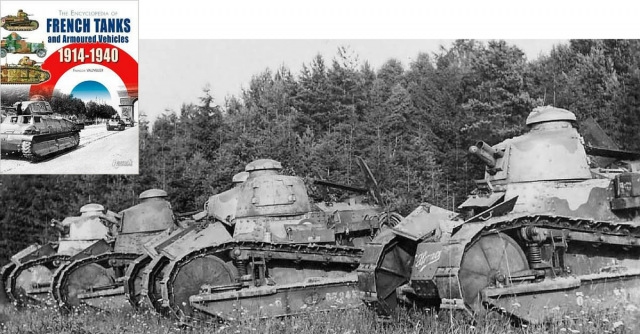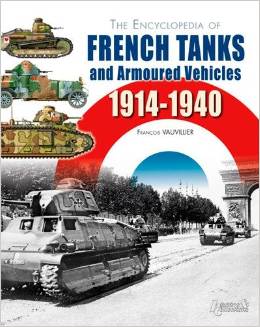I got a first sight of this book at last year’s War & Peace Revival where it was quite appropriate that one of the stars of the show was a Citroen-Kegresse half-track manned by a happy bunch of French re-enactors wearing period kit. I got talking to a French journalist whose grasp of English inevitably put my limited knowledge of his own language to shame and he was fairly guarded in his comments but was, nonetheless, content to tell me that projects to restore a number of armoured vehicles to running order are well under way in France and the likelihood of seeing some classic tanks of the Blitzkrieg era rumbling along is quite strong. That pleases me immensely.
I am unashamed to admit a fondness for French armour and so this book was always going to be an essential read for me. It took a little longer than I intended to secure a review copy but I am happy to confirm that the book proves the wait was worth it.
Here in Britain we can rightly be proud of our place as the birthplace of tank design and operations. Despite their immense significance those rhomboid monsters were pretty soon consigned to history and one of the vehicles to do this was the classic Renault FT17 with its general layout and fully rotating turret propelling tank design into a future we all recognise today. The importance of the little Renault went beyond the physical but also into concepts of how to use them in numbers refined by the French army on the Great War battlefields and also by the pioneering Adna Chaffee and a youngish George Patton. These amazing tanks have turned up literally all over the world and continue to be found in the most surprising of places such as Afghanistan. I have a 37mm shell for one sitting in the hearth of my living room. It was found on a market stall and bought for the equivalent of a US dollar and it is treasured.
I suppose the greatest cultural impact French tanks have had on me is through the near endless stream of stunning photographs showing them coming to all manner of grief during the Battle of France in 1940. Alistair Horne’s classic To Lose a Battle: France 1940 remains a ‘must read’ for budding historians of this period. Amazing as the range of photographs are, they do not do the armoured forces of France any justice. Photographs tend to tell only part of a story. Just as glorious are the shots of armour parading on Bastille Day. Seeing Somuas and Char Bs rumbling down the Champs-Élysées is pretty stirring stuff and happily this book brings us plenty of these images.
The flipside comes on hallowed ground such as at La Fiere on the Merderet River in 1944 where US airborne troops fought against Renault tanks used by the Germans. It is shallow to suggest those tanks were hardly formidable, because none of us writing or reading this review will have had to fight against them and whatever their shortcomings the fact that lightly armed airborne troops were able to stop them says more about the men than the metal. Anyone who claims to love their history should read the glorious No Better Place to Dieto fix names and deeds from that battle in their minds.
The tanks all have a style of their own, but if you want to see how French thinking was progressing take a look in the armoured personnel carrier section of this book and you will see vehicles that were well on the way to being the pretty standard battlefield taxies of the cold war. There are flaws in them, of course, but this evades the point that for all the eccentricities of some French designs, modernity was right round the corner. The author describes these developments as cutting edgeand he is right on the button. The point of all this is to draw attention to the detail and authority brought to bear by the author.
But ultimately it is the classic Renault and Hotchkiss tanks along with the Citroen and Unic half-tracks I wanted to see and the book does not disappoint.
Happily there are some classic tanks of the period on show at the Tank Museum – Bovington, and I hope to get to Saumur one of these days. Even the museum at Latrun has a Hotchkiss H35 amongst its serried ranks soaking up the sun.
This magnificent book is a sumptuous collection of photographs and artwork of all the armoured vehicles made in France from the beginning of the Great War to the disastrous days of 1940. The pages are informative and attractive and I am not phased by knowing the allure of tank porn is in full effect here. I have long made plain my love for books like this and while the illustrations and photographs help it along we have to give Roger Branfill-Cook praise for his translation skills because it would all come to nothing if the thing read badly and, happily, it doesn’t.
I’ve mentioned the artwork, and should give a shout to Eric Schwartz and Laurent Lecocq for their superb work. But the real plaudits have to go to Francois Vauvillier, clearly a man of immense passion and knowledge; the WHO team have admired his books and magazines for many years now and just wish we could get beyond the inevitably rocky schoolboy French we manage to pool together to make more of them. All the style and vision brought to those magazines are on view here. Having English editions of these books is fantastic and I do hope the publisher will do this more often.
I am not sure I am allowed to put a book from last summer into my ‘best of’ pile for 2015, but as it’s my train set I may well do so. I love this book from first to last and while others I reviewed have found their way into the libraries of my mates, this one is going nowhere. Sorry lads.
Reviewed by Mark Barnes for War History Online.
THE ENCYCLOPEDIA OF FRENCH TANKS AND ARMOURED VEHICLES 1914-1940
By Francois Vauvillier
Histoire & Collections
ISBN: 978-2-35250-322-4


